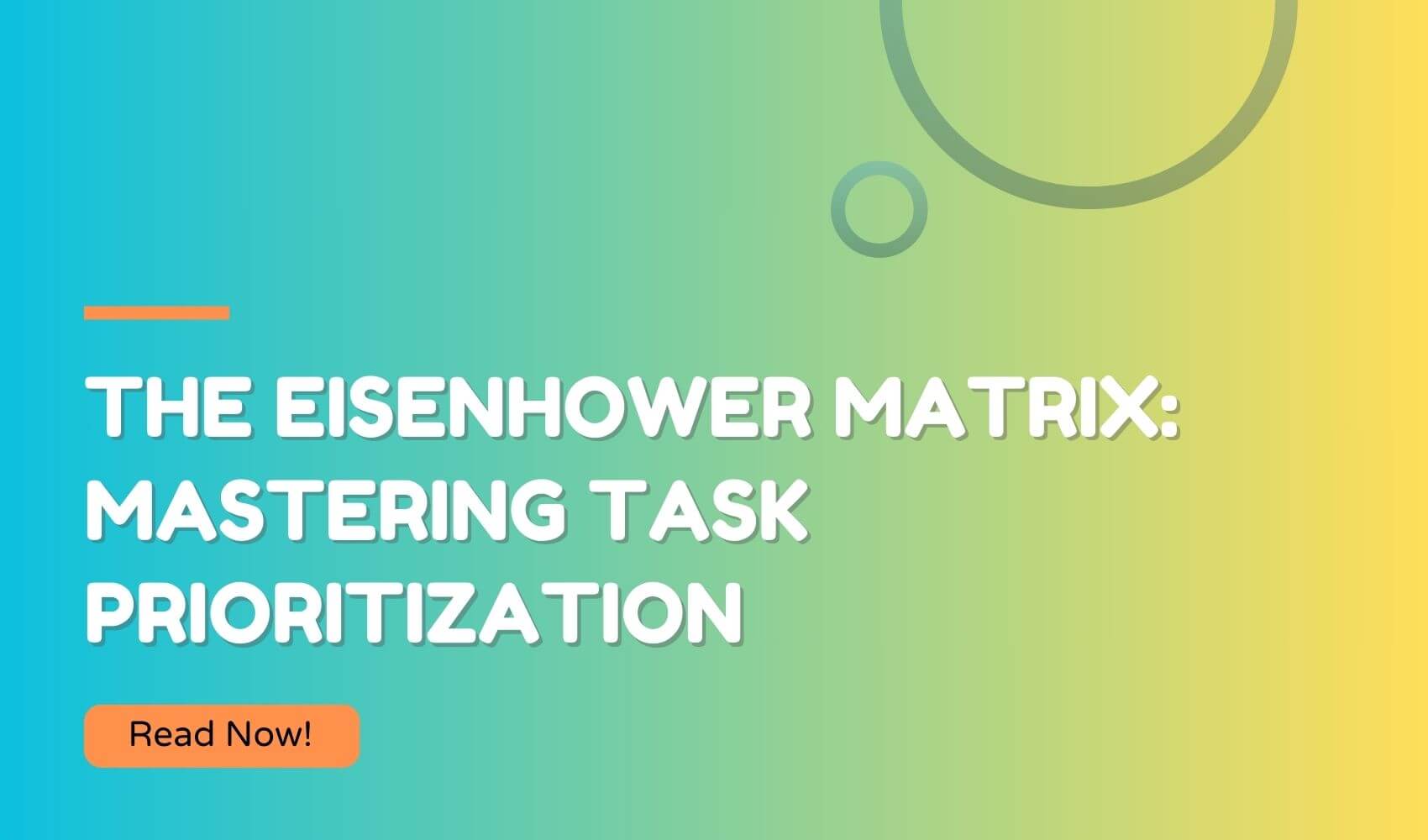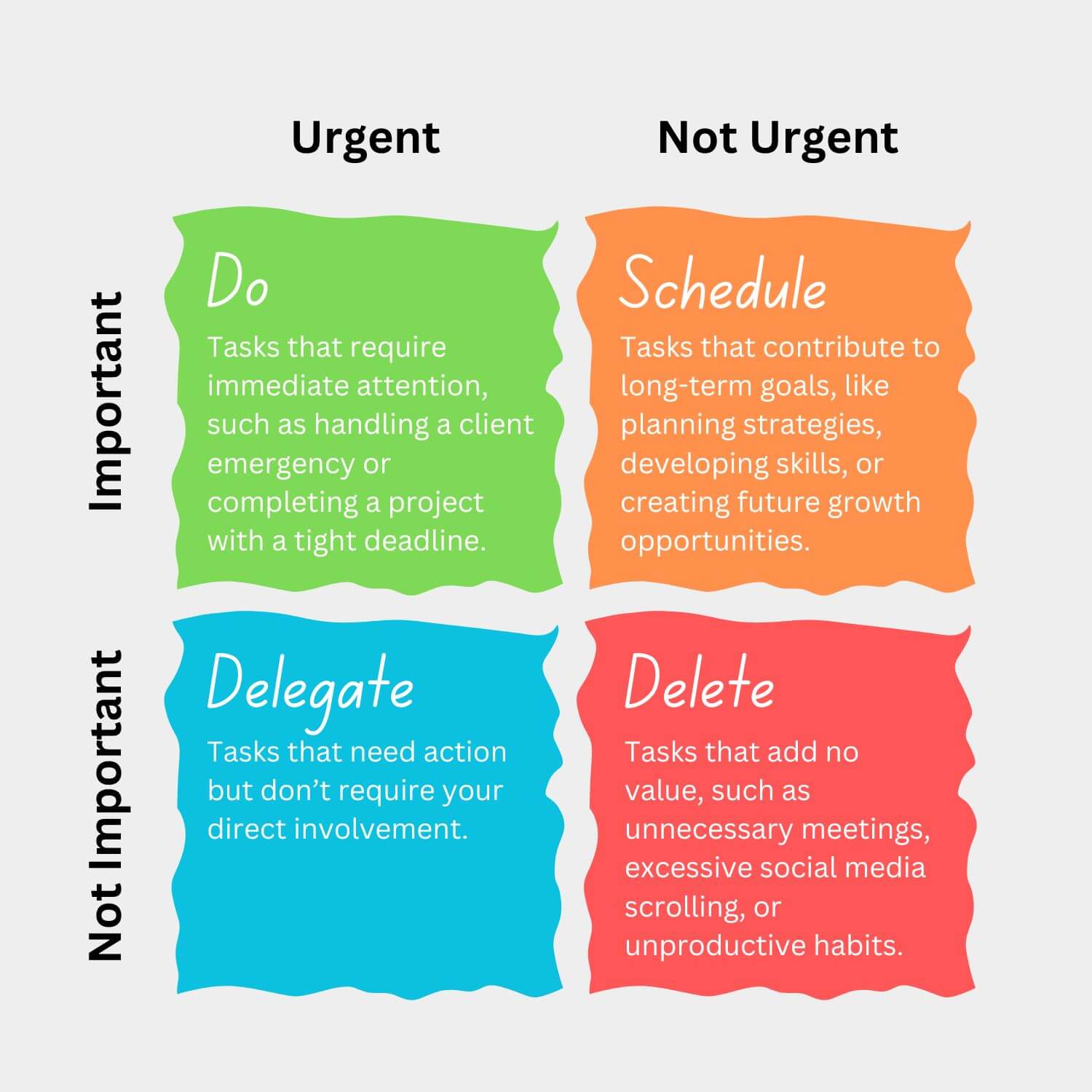By: Tom Dougherty
Published: January 19, 2025

Running a business comes with a constant stream of tasks demanding attention. Deciding what to tackle first can feel overwhelming, especially when everything seems important. For business owners, finding a way to focus on high-impact activities while addressing urgent needs is key to staying productive.
The Eisenhower Matrix offers a practical method to cut through the chaos. It provides a clear framework for organizing tasks based on urgency and importance, helping business owners and their teams work more efficiently.
The Eisenhower Matrix is a decision-making tool that helps prioritize tasks based on urgency and importance. It’s structured into four quadrants, each guiding specific actions:

The matrix was inspired by Dwight D. Eisenhower, a former U.S. president and military leader known for his ability to manage priorities effectively. Its straightforward structure makes it an excellent tool for personal and team use, helping improve focus and productivity.
Managing a business requires making decisions that directly impact time, resources, and outcomes. The Eisenhower Matrix offers a structured way to focus on what matters most, reducing wasted energy on low-priority activities.
For business owners, the framework is particularly effective in balancing personal responsibilities with team needs. Incorporating structured strategies like those offered in business coaching encourages clearer delegation by identifying tasks that can be assigned to employees, freeing up time for strategic thinking.
Regular use of the matrix promotes a more disciplined approach to managing daily operations, helping align actions with long-term goals.
Applying the matrix within a team setting fosters collaboration. It becomes a shared tool for identifying priorities, improving communication, and boosting overall productivity. Business owners who introduce this method to their teams often find it easier to create a culture of focus and accountability.
To get started with the Eisenhower Matrix, begin by listing all current tasks. These can include personal responsibilities, team objectives, or ongoing projects. Once the list is complete, sort each task into one of the four quadrants:
Once tasks are assigned to their respective quadrants, review the list regularly. Priorities shift, and staying adaptable is key. For business owners, the matrix is not only a tool for personal organization but a guide for team collaboration. Involving employees in the process encourages shared ownership of goals and ensures everyone is working on what matters most.
The Eisenhower Matrix can become a powerful tool for team collaboration when used effectively. Start by introducing the concept during a team meeting. Provide a simple explanation of the four quadrants and how they help sort tasks by urgency and importance. Encourage team members to list their responsibilities and categorize them together.
Collaboration is key in making the matrix a shared resource. For example, it can be used to identify tasks that can be delegated or streamlined. Discuss what falls into the “urgent and important” category to ensure these priorities are clear to everyone. Similarly, reviewing the “important but not urgent” tasks as a team can highlight opportunities for long-term planning and growth.
Providing examples specific to your business can help employees better understand how to apply the matrix. For instance, meeting a key client deadline might fall into the urgent and important quadrant, while preparing for a new product launch could sit in the important but not urgent section. Using relatable scenarios makes the process more engaging and actionable.
Regular team check-ins can be an effective way to review the matrix together. These sessions allow adjustments to be made, tasks to be reassigned, and priorities to be realigned with evolving goals. Over time, the matrix fosters a culture of accountability and strategic focus, benefiting both individual team members and the business as a whole.
For business owners and teams, having a template or tool can make it easier to adopt the Eisenhower Matrix. Start with a basic grid format—four equal sections labeled with the quadrants: Urgent and Important, Important but Not Urgent, Urgent but Not Important, and Neither Urgent nor Important. A whiteboard or simple piece of paper works well for team discussions, while digital tools offer added flexibility.
Templates available online can be downloaded and customized to fit specific business needs. These are helpful for individuals and teams looking to integrate the matrix into their daily workflow. Applications such as Trello, Asana, or Notion offer built-in features that allow tasks to be sorted into categories resembling the matrix structure. These tools often include reminders and scheduling capabilities, making it easy to manage tasks on the go.
For those who prefer a minimalist approach, even a shared spreadsheet can be an effective way to track and prioritize tasks. The goal is to create a system that feels natural to use and encourages regular updates. Introducing templates and tools during team training sessions can help everyone understand how to use the matrix consistently, fostering a unified approach to task prioritization.
The Eisenhower Method brings clarity to decision-making by helping business owners focus on tasks that truly matter. It reduces overwhelm and improves efficiency by categorizing tasks based on urgency and importance, creating a roadmap for action.
For business owners, the method simplifies delegation. By identifying tasks in the “Urgent but Not Important” quadrant, leaders can assign these to team members, freeing up their time for strategic initiatives. Delegating effectively builds trust and accountability within the team, fostering a more collaborative environment.
The method also supports better time management. Tasks in the “Important but Not Urgent” quadrant highlight opportunities for long-term planning, such as developing growth strategies or implementing new systems. Scheduling these tasks prevents them from being overlooked.
Lastly, eliminating distractions in the “Neither Urgent nor Important” category allows the entire team to focus on high-value activities. Over time, this approach boosts productivity, aligns efforts with business goals, and creates a structured framework for sustainable growth.
Consistency plays a significant role in making the Eisenhower Matrix effective. Regularly reviewing tasks, either daily or weekly, keep priorities clear and aligned with business goals. Both individual and team use of the matrix can bring structure and a sense of purpose to task management.

Small adjustments can enhance its impact over time. For instance, team discussions focused on the “Important but Not Urgent” quadrant may reveal areas for long-term growth. Similarly, removing unnecessary activities from the “Neither Urgent nor Important” quadrant helps save time and energy for tasks that add value.
Recognize the results of better prioritization. Highlighting successes, such as completing impactful projects or improving team productivity, reinforces the method’s benefits. Positive outcomes encourage continued use and refinement, making the matrix an integral part of daily operations.
With regular application, the Eisenhower Matrix fosters a more organized and productive environment. It helps business owners and their teams stay focused on meaningful tasks while eliminating unnecessary distractions, leading to greater efficiency and progress over time.
The Eisenhower Matrix offers a straightforward way to organize tasks and make better use of time. For business owners, it’s a tool that helps prioritize actions, delegate responsibilities, and eliminate unnecessary distractions. When introduced to a team, it creates a shared framework that fosters collaboration and accountability.
Taking the first step is simple. Begin with a clear list of tasks and sort them into the four quadrants. Encourage regular reviews and make adjustments as priorities shift. Over time, the matrix will become second nature, bringing clarity and focus to both personal and team workflows.
Start using the Eisenhower Matrix today to create a more productive and organized approach to managing your business. Consistent application will help you and your team focus on what truly matters and build momentum toward achieving your goals.
Let ActionCOACH of Arizona help you streamline your goals and unlock your full potential.

At ActionCOACH of Arizona, we help entrepreneurs and business owners unlock their full potential with proven strategies, powerful coaching, and real results. Whether you're scaling, streamlining, or just starting out—we’ve got your back.